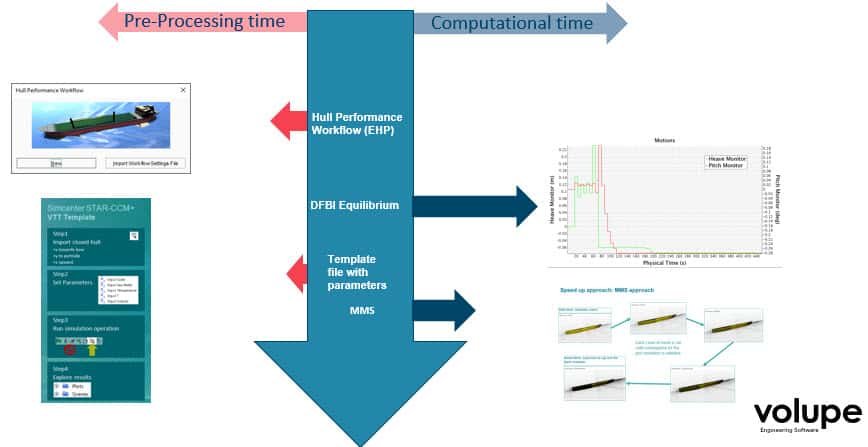From CAD to complete simulation
Let´s be honest, hull performance simulations are quite complicated. We two have immiscible fluids, a body that is in motion as subject to those fluids and flow phenomena of high complexity, such as vortices and separation. Luckily, over the years the developers of Simcenter STAR-CCM+ have made some efforts to assist the pre-processing and to reduce the computational time for hydrodynamic simulation of ships.

The typical process to set up a standard resistance calculation involves:
- Import of CAD geometry
- Check of quality and orientation of the model
- Applying hydrostatic properties
- Definition of mesh refinements to capture expected flow
- Prism layer definition to capture boundary layer
- Setup of physics for the simulation (such as appropriate time step, solvers, turbulence model, ramping)
- Definition of free-surface and boundary conditions
HPW
Only the manual setup of the mesh often involves a dozen refinements and can become cumbersome and time consuming. The first step to assist the pre-processing for marine application was made when the Hull Performance Workflow (HPW) was released as an add-on to Simcenter STAR-CCM+. HPW provides a dedicated user interface to guide you through simulations of ship hull motion in calm water. It is designed to be used by non-expert users as well as experienced engineers. And HPW allows geometry-to-solution and post processing in just a few clicks. HPW will configure all aspects of the CFD model and compile results and post processing in a PowerPoint document.
DFBI-Equilibrium
The computational time could be reduced with the introduction of DFBI-Equilibrium. This key technology of Simcenter STAR-CCM+ uses a pseudo-steady approach to incrementally displace the body to the current estimate of equilibrium position. The flow then adjusts to the new position. The final equilibrium position is typically found in a small number of updates. In many cases close to an order or magnitude speed up over a traditional free motion transient approach can be obtained.

The method requires a stable equilibrium to exist, where a force balance exists as a result of the body’s position. This method is not suitable for lifting bodies, where the lift is primarily a function of pitch and velocity, and not a function of vertical position. Consequently the primary use case for this functionality is marine sink and trim simulations.
Template
Most recently, the parameters and template approach allow you to populate a simulation file with its best practices settings where you can easily replace the geometry and update the simulation with only a handful of parameters.
A template uses logic-based workflows and is completely open. You have access to all controls and can easily adapt to your best practice setup (no scripting, code update). This allows you to quickly automate your process and analyse of new designs. Consequently, it reduces not only the amount of time you’re taking setting up and running repeated design, but also lets you reduce errors during the setup.

This saved some preprocessing time which is now taking up to 5min for a new simulation.
Please stay tuned for an upcoming webinar on the use and a look-under-the-hood of these fantastic tools. And as usual if you have any question do not hesitate to send us a question at support@volupe.com
Read also:
Hull Performance Simulation, easy!
Marine simulation with Simcenter STAR-CCM+
Life as an Application Support Engineer
Templating, an internal flow example




